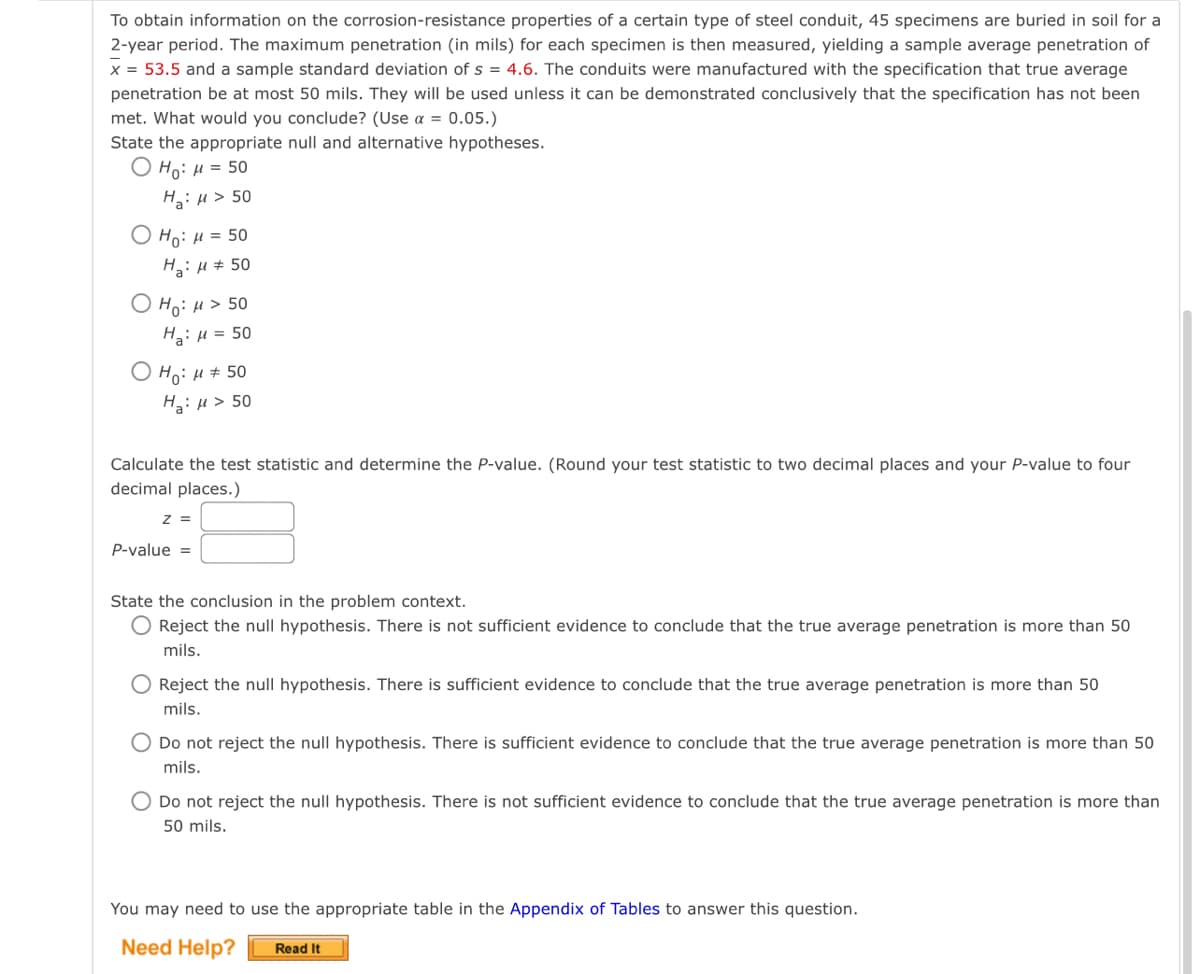To obtain information on the corrosion-resistance properties of a certain type of steel conduit, 45 specimens are buried in soil for a 2-year period. The maximum penetration (in mils) for each specimen is then measured, yielding a sample average penetration of x = 53.5 and a sample standard deviation of s = 4.6. The conduits were manufactured with the specification that true average penetration be at most 50 mils. They will be used unless it can be demonstrated conclusively that the specification has not been met. What would you conclude? (Use a = 0.05.) State the appropriate null and alternative hypotheses.
To obtain information on the corrosion-resistance properties of a certain type of steel conduit, 45 specimens are buried in soil for a 2-year period. The maximum penetration (in mils) for each specimen is then measured, yielding a sample average penetration of x = 53.5 and a sample standard deviation of s = 4.6. The conduits were manufactured with the specification that true average penetration be at most 50 mils. They will be used unless it can be demonstrated conclusively that the specification has not been met. What would you conclude? (Use a = 0.05.) State the appropriate null and alternative hypotheses.
MATLAB: An Introduction with Applications
6th Edition
ISBN:9781119256830
Author:Amos Gilat
Publisher:Amos Gilat
Chapter1: Starting With Matlab
Section: Chapter Questions
Problem 1P
Related questions
Question
100%
Can someone please explain it to me ASAP???!!!!

Transcribed Image Text:To obtain information on the corrosion-resistance properties of a certain type of steel conduit, 45 specimens are buried in soil for a
2-year period. The maximum penetration (in mils) for each specimen is then measured, yielding a sample average penetration of
x = 53.5 and a sample standard deviation of s = 4.6. The conduits were manufactured with the specification that true average
penetration be at most 50 mils. They will be used unless it can be demonstrated conclusively that the specification has not been
met. What would you conclude? (Use a = 0.05.)
State the appropriate null and alternative hypotheses.
O Ho: H = 50
H3: H > 50
Ο Hg: μ- 50
H: µ # 50
O Hoi H> 50
HaiH = 50
O Ho: H# 50
H:µ > 50
Calculate the test statistic and determine the P-value. (Round your test statistic to two decimal places and your P-value to four
decimal places.)
z =
P-value =
State the conclusion in the problem context.
O Reject the null hypothesis. There is not sufficient evidence to conclude that the true average penetration is more than 50
mils.
Reject the null hypothesis. There is sufficient evidence to conclude that the true average penetration is more than 50
mils.
O Do not reject the null hypothesis. There is sufficient evidence to conclude that the true average penetration is more than 50
mils.
O Do not reject the null hypothesis. There is not sufficient evidence to conclude that the true average penetration is more than
50 mils.
You may need to use the appropriate table in the Appendix of Tables to answer this question.
Need Help?
Read It
Expert Solution
This question has been solved!
Explore an expertly crafted, step-by-step solution for a thorough understanding of key concepts.
Step by step
Solved in 2 steps

Recommended textbooks for you

MATLAB: An Introduction with Applications
Statistics
ISBN:
9781119256830
Author:
Amos Gilat
Publisher:
John Wiley & Sons Inc

Probability and Statistics for Engineering and th…
Statistics
ISBN:
9781305251809
Author:
Jay L. Devore
Publisher:
Cengage Learning

Statistics for The Behavioral Sciences (MindTap C…
Statistics
ISBN:
9781305504912
Author:
Frederick J Gravetter, Larry B. Wallnau
Publisher:
Cengage Learning

MATLAB: An Introduction with Applications
Statistics
ISBN:
9781119256830
Author:
Amos Gilat
Publisher:
John Wiley & Sons Inc

Probability and Statistics for Engineering and th…
Statistics
ISBN:
9781305251809
Author:
Jay L. Devore
Publisher:
Cengage Learning

Statistics for The Behavioral Sciences (MindTap C…
Statistics
ISBN:
9781305504912
Author:
Frederick J Gravetter, Larry B. Wallnau
Publisher:
Cengage Learning

Elementary Statistics: Picturing the World (7th E…
Statistics
ISBN:
9780134683416
Author:
Ron Larson, Betsy Farber
Publisher:
PEARSON

The Basic Practice of Statistics
Statistics
ISBN:
9781319042578
Author:
David S. Moore, William I. Notz, Michael A. Fligner
Publisher:
W. H. Freeman

Introduction to the Practice of Statistics
Statistics
ISBN:
9781319013387
Author:
David S. Moore, George P. McCabe, Bruce A. Craig
Publisher:
W. H. Freeman